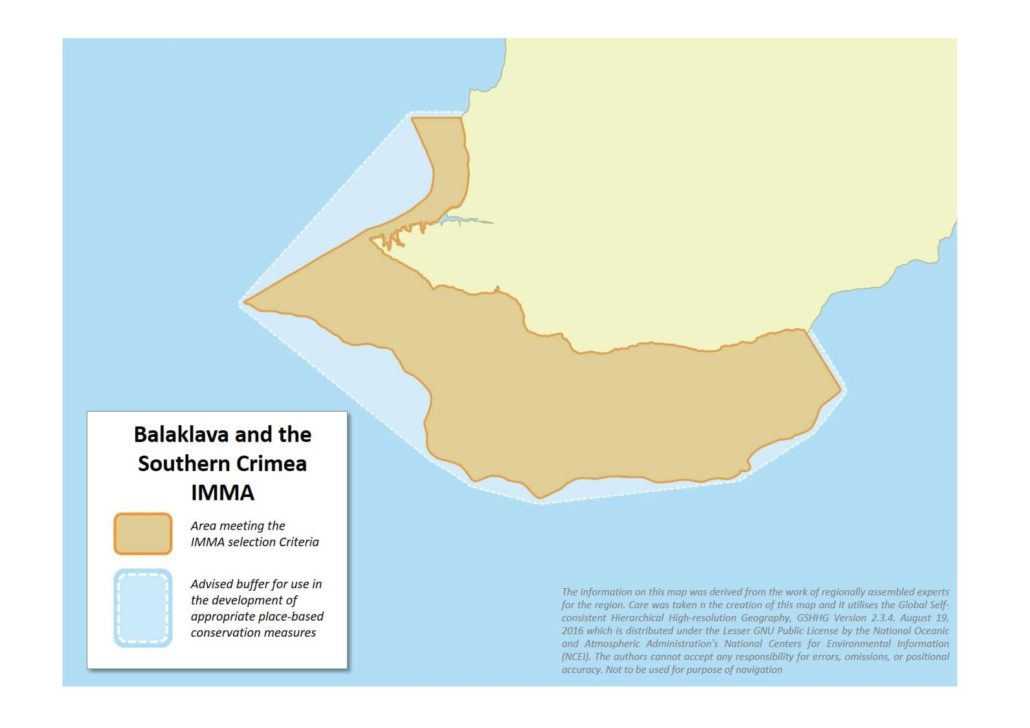Balaklava and the southern Crimea IMMA
Size in Square Kilometres
1 913 km2
Qualifying Species and Criteria
Black Sea bottlenose dolphin – Tursiops truncatus ponticus
Criterion A, B(2), C(1, 2)
Marine Mammal Diversity
Tursiops truncatus ponticus, Phocoena phocoena relicta, Delphinus delphis ponticus
Download fact sheet
Summary
The Balaklava and the Southern Crimea IMMA encompasses coastal waters between the Ulukol (Lukull) Cape and Ai-Todor Cape in the northern Black Sea, and includes waters at depths up to 200 m. Three Black Sea cetacean species inhabit the IMMA: common dolphin (Delphinus delphis ponticus), harbour porpoise (Phocoena phocoena relicta) and bottlenose dolphin (Tursiops truncatus ponticus). The IMMA provides important habitat for the local coastal population of bottlenose dolphins, which consists of several hundred individuals. It was identified as an important cetacean habitat by Birkun (2006) and adopted as Cetacean Critical Habitat by ACCOBAMS. The IMMA also includes the Biologically Significant Marine Area Balaklava.
Description of Qualifying Criteria
Criterion A – Species or Population Vulnerability
Balaklava and southern Crimean waters constitute important habitat for the three threatened Black Sea cetacean subspecies, the Endangered harbour porpoise (Phocoena phocoena relicta) and bottlenose dolphin (Tursiops truncatus ponticus) and the Vulnerable common dolphin (Delphinus delphis ponticus) (Birkun, 2002, 2012; Mikhalev, 2005a,b, 2008; Birkun and Frantzis, 2008; Birkun and Krivokhizhin, 2011).
Criterion B: Distribution and Abundance
Sub-criterion B2: Aggregations
A local coastal population of several hundred bottlenose dolphins has been estimated from vessel-based photo-identification surveys conducted between Foros Cape and Sarych Cape from 2012-2014 (Gladilina et al., 2018). The longest time period between re-sighting of the same individuals in the area was 18 years (Gladilina, 2018).
According to the results of research by Birkun and colleagues in the 1990s and early 2000s and by Gladilina in the 2010s, large aggregations of bottlenose dolphins have been observed in the area with maximum observed group sizes up to 60-150 dolphins in spring (Gladilina, 2018; Gladilina, personal communication) and up to 150-200 dolphins in autumn (42% of groups include at least 40 dolphins) (Birkun, 2003).
Criterion C: Key Life Cycle Activities
Sub-criterion C1: Reproductive Areas
This IMMA is important for the bottlenose dolphins with calves. Around 50% of sightings include groups with calves, and 21% include neonates (Gladilina, 2018). Birkun (2006b), based on direct observations during several years, stated the hypothesis that the Balaklava area might be the most important breeding place for bottlenose dolphins in the entire Black Sea, facilitating mixing between the different Black Sea local populations.
Sub-criterion C2: Feeding Areas
This area has a high concentration of important prey fish of bottlenose dolphins, like mullet, horse mackerel, whiting, garfish, red mullet and anchovy (Drodzov, 2011; Kuzminova, 2013). The main type of behaviour recorded by bottlenose dolphins observed in the area is foraging, and feeding aggregations are up to 60-150 animals (Gladilina, 2018; Gladilina, personal communication).
Supporting Information
Birkun, Jr, A. 2002. The current status of bottlenose dolphins (Tursiops truncatus) in the Black Sea. In Report of the first meeting of the Parties to the Agreement on the Conservation of Cetaceans of the Black Sea, Mediterranean Sea and contiguous Atlantic area (ACCOBAMS). Document AC18-Inf. 2. 25 pp.
Birkun, Jr, A. 2003. Assessment of the state of the Red Book marine mammals populations of the Azov and Black Seas. In Final report on research work MS-2003. BREMA Laboratory, Ukraine. 222 pp. [In Russian]
Birkun, Jr., A.A. (comp.). 2006. Conservation Plan for Black Sea Cetaceans. ACCOBAMS and Black Sea Commission. 50 pp.
Birkun, A.A. 2006b. Cetaceans. North-West Part of The Black Sea: Biology And Ecology, Naukova Dumka:314-332 [In Russian].
Birkun, Jr., A.A. and Frantzis, A. 2008. Phocoena phocoena ssp. relicta. The IUCN Red List of Threatened Species 2008: e.T17030A6737111. http://dx.doi.org/10.2305/IUCN.UK.2008.RLTS.T17030A6737111.en.
Birkun, A. 2012. Tursiops truncatus ssp. ponticus. The IUCN Red List of Threatened Species 2012: e.T133714A17771698. http://dx.doi.org/10.2305/IUCN.UK.2012.RLTS.T133714A17771698.en.
BLASDOL. 1999. Estimation of human impact on small cetaceans of the Black Sea and elaboration of appropriate conservation measures: final report for EC Inco-Copernicus (contract No. ERBIC15CT960104). C. R. Joiris (Coord.), Free University of Brussels, Belgium; BREMA Laboratory, Ukraine; Justus Liebig University of Giessen, Germany; Institute of Fisheries, Bulgaria; and Institute of Marine Ecology and Fisheries, Georgia. Brussels. 113 pp.
Drozdov, V.V. 2011. ‘Long-term variability of fishery resources of the Black Sea, tendencies, the reasons and prospects’. Uchenye zapiski RGGMU V 21:137-154.
Gladilina, O.V. 2018. The bottlenose dolphin (Tursiops truncatus) in the waters of the northern Black Sea: biology and population structure. Dissertation submitted for the completion of the degree of Candidate of Sciences in Biology, qualification 03.00.08, zoology. Schmalhausen Institute of Zoology, National Academy of Sciences of Ukraine. Kyiv. 215 p.
Gladilina, E., Shpak, O., Serbin, V., Kryukova, A., Glazov, D. and Gol’din, P. 2018. ‘Individual movements between local coastal populations of bottlenose dolphins (Tursiops truncatus) in the northern and eastern Black Sea’. Journal of the Marine Biological Association of the United Kingdom, 98(2);223-229. doi:10.1017/S0025315416001296
Gol’din, P. 2004. ‘Growth and body size of the harbour porpoise, Phocoena phocoena (Cetacea, Phocoenidae), in the Sea of Azov and the Black Sea’.Vestinik zoologii 38(4):59-73.
Kuzminova, N.S. 2013. ‘Population parameters of horse mackerel in various water areas of the Black Sea in the modern period’. Ribogospodarka Science of Ukraine, No. 3:35-45.
Mikhalev, Yu.A. 2005a. ‘The peculiarities of the distribution of the bottlenose dolphin, Tursiops truncatus (Cetacea), in the Black Sea’. Vestnik Zoologii 39:29–42. [In Russian]
Mikhalev, Yu.A. 2005b. ‘The Peculiarities of the Distribution of the Harbour Porpoise, Phocoena phocoena relicta (Cetacea), in the Black Sea’. Vestnik Zoologii 39(6):25–35 [In Russian].
Mikhalev, Yu.A. 2008. ‘Characteristics of Distribution of the Common Dolphins, Delphinus delphis (Cetacea), in the Black Sea’. Vestnik Zoologii 42(4):325–337 [In Russian].
Cetacean sightings in the Black Sea, Sea of Azov and Kerch Strait (CetSiBS). 2011. Dataset assembled by A.Birkun, Jr. and S.Krivokhizhin. EMODNet. https://obis.org/dataset/db99b405-1b51-432b-86b6-cc77465d08c5


